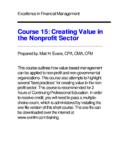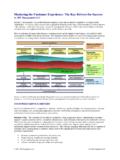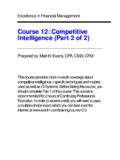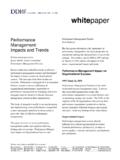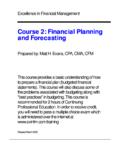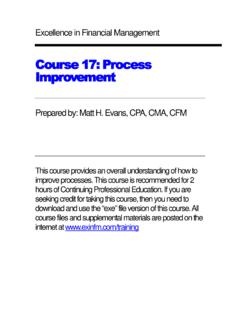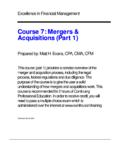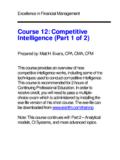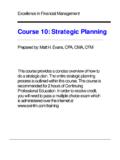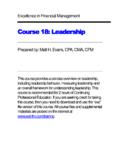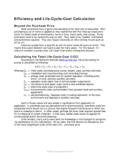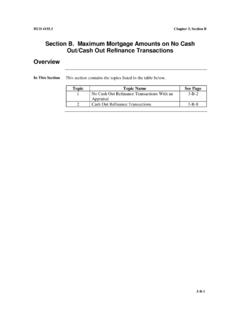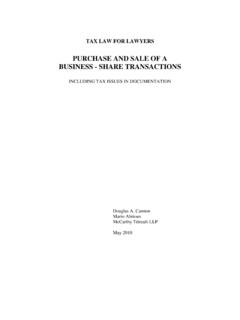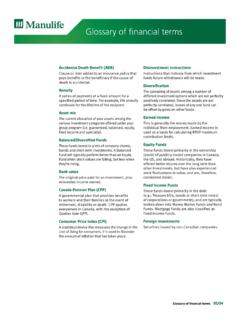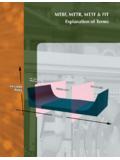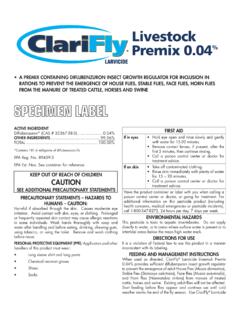Transcription of Course 7: Mergers & Acquisitions (Part 2)
1 Course 7: Mergers & Course 7: Mergers & Course 7: Mergers & Course 7: Mergers & Acquisitions (Part 2) Acquisitions (Part 2) Acquisitions (Part 2) Acquisitions (Part 2)Prepared by: Matt H. Evans, CPA, CMA, CFMPart 2 of this Course continues with an overview of themerger and acquisition process, including the valuationprocess, post merger integration and anti-takeoverdefenses. The purpose of this Course is to give the user asolid understanding of how Mergers and acquisitionswork. This Course deals with advanced concepts invaluation. Therefore, the user should have anunderstanding of cost of capital, forecasting, and valuebased management before taking this Course . Thiscourse is recommended for 2 hours of ContinuingProfessional Education. In order to receive credit, you willneed to pass a multiple choice exam which isadministered over the internet at June 2000 Excellence in Financial ManagementValuation Concepts & StandardsAs indicated in Part 1 of this Short Course , a major challenge within the merger andacquisition process is due diligence.
2 One of the more critical elements within due diligence isvaluation of the Target need to assign a value or more specifically a range of values to the Target Company sothat we can guide the merger and acquisition process. We need answers to severalquestions: How much should we pay for the target company, how much is the target worth,how does this compare to the current market value of the target company, should be noted that the valuation process is not intended to establish a selling price for theTarget Company. In the end, the price paid is whatever the buyer and the seller agree valuation decision is treated as a capital budgeting decision using the Discounted CashFlow (DCF) Model. The reason why we use the DCF Model for valuation is because:! Discounted Cash Flow captures all of the elements important to valuation.! Discounted Cash Flow is based on the concept that investments add value when returnsexceed the cost of capital.
3 ! Discounted Cash Flow has support from both research and within the valuation computation includes the following steps:1. Discounting the future expected cash flows over a forecast Adding a terminal value to cover the period beyond the forecast Adding investment income, excess cash, and other non-operating assets at their Subtracting out the fair market values of debt so that we can arrive at the value of we get into the valuation computation, we need to ask: What are we trying to value?Do we want to assign value to the equity of the target? Do we value the Target Company ona long-term basis or a short-term basis? For example, the valuation of a company expectedto be liquidated is different from the valuation of a going Mergers and Acquisitions are directed at acquiring the equity of the Target , when you acquire ownership (equity) of the Target Company, you will assume theoutstanding liabilities of the target.
4 This will increase the purchase price of the 1 - Determine purchase Price of Target CompanyEttco has agreed to acquire 100% ownership (equity) of Fulton for $ 100million. Fulton has $ 35 million of liabilities Paid to Acquire Fulton$ 100 millionOutstanding Liabilities Assumed 35 millionTotal purchase Price$ 135 millionKey Point Ettco has acquired Fulton based on the assumption thatFulton's business will generate a Net Present Value of $ 135 publicly traded companies, we can get some idea of the economic value of a company bylooking at the stock market price. The value of the equity plus the value of the debt is the totalmarket value of the Target 2 - Total Market Value of Target CompanyReferring back to Example 1, assume Fulton has 2,500,000 shares of stockoutstanding. Fulton's stock is selling for $ per share and the fairmarket value of Fulton's debt is $ 40 Value of Stock (2,500,000 x $ ) $ 150 millionMarket Value of Debt 40 millionTotal Market Value of Fulton$ 190 millionA word of caution about relying on market values within the stock market; stocks rarely tradein large blocks similar to merger and acquisition transactions.
5 Consequently, if the publiclytraded target has low trading volumes, then prevailing market prices are not a reliableindicator of StreamsOne of the dilemmas within the merger and acquisition process is selection of incomestreams for discounting. Income streams include Earnings, Earnings Before Interest & Taxes(EBIT), Earnings Before Interest Taxes Depreciation & Amortization (EBITDA), OperatingCash Flow, Free Cash Flow, Economic Value Added (EVA), financial management, we recognize that value occurs when there is a positive gapbetween return on invested capital less cost of capital. Additionally, we recognize thatearnings can be judgmental, subject to accounting rules and distortions. Valuations need tobe rooted in "hard numbers." Therefore, valuations tend to focus on cash flows, such asoperating cash flows and free cash flows over a projected forecast Cash FlowOne of the more reliable cash flows for valuations is Free Cash Flow (FCF).
6 FCF accounts forfuture investments that must be made to sustain cash flow. Compare this to EBITDA, whichignores any and all future required investments. Consequently, FCF is considerably morereliable than EBITDA and other earnings-based income streams. The basic formula forcalculating Free Cash Flow (FCF) is:FCF = EBIT (1 - t ) + Depreciation - Capital Expenditures + or - Net Working Capital( 1 - t ) is the after tax percent, used to convert EBIT to after is added back since this is a non-cash flow item within EBITC apital Expenditures represent investments that must be made to replenish assets andgenerate future revenues and cash Working Capital requirements may be involved when we make capital investments. Atthe end of a capital project, the change to working capital may get 3 - Calculation of Free Cash FlowEBIT$ 400 Less Cash Taxes (130)Operating Profits after taxes 270 Add Back Depreciation 75 Gross Cash Flow 345 Change in Working Capital 42 Capital Expenditures (270)Operating Free Cash Flow 117 Cash from Non Operating Assets * 10 Free Cash Flow$ 127* Investments in Marketable SecuritiesIn addition to paying out cash for capital investments, we may find that we have some fixedobligations.
7 A different approach to calculating Free Cash Flow is:FCF = After Tax Operating Tax Cash Flow - Interest ( 1 - t ) - PD - RP - RD - EPD: Preferred Stock DividendsRP: Expected Redemption of Preferred StockRD: Expected Redemption of DebtE: Expenditures required to sustain cash flows4 Example 4 - Calculation of Free Cash FlowThe following projections have been made for the year 2005:! Operating Cash Flow after taxes are estimated as $ 190,000! Interest payments on debt are expected to be $ 10,000! Redemption payments on debt are expected to be $ 40,000! New investments are expected to be $ 20,000! The marginal tax rate is expected to be 30%After Tax Operating Cash Flow$ 190,000 Less After Tax Depreciation ($10,000 x (1 - .30)) ( 7,000)Debt Redemption Payment (40,000)New Investments (20,000)Free Cash Flow$ 123,000 Discount RateNow that we have some idea of our income stream for valuing the Target Company, we needto determine the discount rate for calculating present values.
8 The discount rate used shouldmatch the risk associated with the free cash flows. If the expected free cash flows are highlyuncertain, this increases risk and increases the discount rate. The riskier the investment, thehigher the discount rate and vice versa. Another way of looking at this is to ask yourself -What rate of return do investors require for a similar type of investment?Since valuation of the target's equity is often the objective within the valuation process, it isuseful to focus our attention on the "targeted" capital structure of the Target Company. Areview of comparable firms in the marketplace can help ascertain targeted capital on this capital structure, we can calculate an overall weighted average cost of capital(WACC). The WACC will serve as our base for discounting the free cash flows of the ApplicationsValuing a target company is more or less an extension of what we know from capitalbudgeting.
9 If the Net Present Value of the investment is positive, we add value through amerger and 5 - Calculate Net Present ValueShannon Corporation is considering acquiring Dalton Company for $100,000 in cash. Dalton's cost of capital is 16%. Based on market analysis,a targeted cost of capital for Dalton is 12%. Shannon has estimated thatDalton can generate $ 9,000 of free cash flows over the next 12 Net Present Value, should Shannon acquire Dalton?5 Initial Cash Outlay$ (100,000)FCF of $ 9,000 x * 55,750 Net Present Value $ ( 44,250)* present value factor of annuity at 12%, 12 on NPV, Shannon should not acquire Dalton since there is anegative NPV for this also need to remember that some Acquisitions are related to physical assets and someassets may be sold after the 6 - Calculate Net Present ValueBishop Company has decided to sell its business for a sales price of $50,000.
10 Bishop's Balance Sheet discloses the following:Cash$ 3,000 Accounts Receivable 7,000 Inventory 12,000 Equipment - Dye 115,000 Equipment - Cutting 35,000 Equipment - Packing 30,000 Total Assets$ 202,000 Liabilities 80,000 Equity 122,000 Total Liab & Equity$ 202,000 Allman Company is interested in acquiring two assets - Dye and CuttingEquipment. Allman intends to sell all remaining assets for $ 35,000. Allmanestimates that total future free cash flows from the dye and cuttingequipment will be $ 26,000 per year over the next 8 years. The cost ofcapital is 10% for the associated free cash flows. Ignoring taxes, shouldAllman acquire Bishop for $ 50,000?Amount Paid to Bishop$ (50,000)Amount Due Creditors (80,000)Less Cash on Hand 3,000 Less Cash from Sale of Assets 35,000 Total Initial Cash Outlay$ (92,000)Present Value of FCF's for 8 yearsat 10% - $ 26,000 x 138,707 Net Present Value (NPV)$ 46,707 Based on NPV, Allman should acquire Bishop for $ 50,000 since there is apositive NPV of $ 46, solid estimation of incremental changes to cash flow is critical to the valuation of the variability of what can happen in the future, it is useful to run cash flowestimates through sensitivity analysis, using different variables to assess "what if" typeanalysis.
